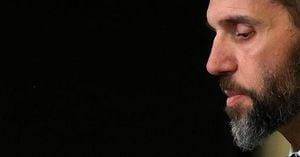A lively debate is heating up around the Federal Reserve's anticipated move to cut interest rates as the year draws to a close. The rumblings of this discussion come from key officials within the Fed, with Christopher Waller, one of its Board members, expressing his leanings toward supporting such a cut during the next Federal Open Market Committee meeting slated for December 17-18.
At a conference held at George Washington University, Waller made his position clear, stating, "At present, I lean toward supporting a cut to the policy rate at our December meeting." His optimism rests on the belief, bolstered by data, showing inflation is slowly heading lower, which would typically warrant adjustments to interest rates. Nevertheless, he tempered this excitement by acknowledging the risks associated with inflation potentially remaining stubbornly above the Fed's target of 2%.
Waller's cautious optimism reflects the state of the economy, which has seen some ups and downs recently. After several strong quarters, growth was reported at 2.8% annually during the third quarter of 2024, but October's figures spotlighted some renewed inflationary pressures. The personal consumption expenditures price index, the Fed's preferred inflation measure, ticked up to 2.3% annually, hinting at slow progress toward the central bank's goal.
Interestingly, Waller's remarks stand out against the backdrop of mixed signals from the economy. While consumer spending remains solid, there's growing apprehension among economists about the durability of this progress. Waller metaphorically summed up his dilemma, mentioning, "I feel like an MMA fighter who keeps getting inflation in a choke hold, waiting for it to tap out, yet it keeps slipping out of my grasp at the last minute."
This illustration aptly captures the Fed's struggle to control inflation – it’s always close but never quite succumbs to the downturn they’re striving for. Waller reiterated his intent to assess incoming data closely as the meeting approaches. "If the data we receive between today and the next meeting surprise me, then I will be supportive of keeping our policy rate constant," he stated.
Despite the uncertainty, Waller believes there’s minimal risk tied to cutting the rates again. He argued, "Cutting again will only mean we aren’t pressing on the brake pedal quite as hard.” This statement points to the Fed's continuous efforts to strike the right balance between stimulating the economy and curbing inflation.
Further complicate the narrative, another significant player, Mary Daly, the President of the San Francisco Fed, voiced more caution. Speaking during her recent interview, she highlighted the need for careful adjustments to the Fed's policies moving forward, emphasizing the importance of recalibrations to maintain economic health. “Now, whether it will be in December or sometime later, that's a question we'll have the chance to debate and discuss at our next meeting,” Daly said, hinting at the complexity of the decision-making process.
Daly’s remarks suggest she may lean less toward immediate action, contrasting Waller's assertiveness. The likely divergence of opinions among Fed officials could shape the final decision come mid-December. Financial markets, for their part, seem to be anticipating the Fed's move, with estimates showing about 70% of traders betting on at least a quarter-point cut.
Despite the speculation, underlying economic fundamentals remain relatively strong. Unemployment sits at around 4.1%, which is quite low by historical standards. Nevertheless, other factors, such as sluggish wage growth, which has dipped below 4% annually, cast shadows on future growth trajectories. These mixed indicators create unnecessary pressure, leaving many wondering about the Fed's next steps.
Waller’s recent comments reverberate against the backdrop of President-elect Donald Trump's victory, which has added layers of complexity to economic forecasts. Trump's policies, some predict, could lead to tariff fluctuations and potential disruptions to employment, influencing inflation metrics unexpectedly.
Concerns about inflation potential have led some economists to believe the Fed may adopt a more cautious approach moving forward, as hinted by Minneapolis Fed President Neel Kashkari. His words suggest hesitation over rapid rate cuts if incoming data doesn’t align with forecasts before the upcoming meeting.
The anticipation builds with each passing day as economic indicators are tracked and addressed. With the Bureau of Labor Statistics set to release job openings and nonfarm payroll data, many are eagerly awaiting insights on the labor market. Should the reports show promise and inflation developments take a favorable turn, Waller's initial lean toward rate cuts could swiftly shift toward actions.
Market analysts continue dissecting these economic shifts and signals, keeping close tabs on Federal Reserve discussions and public comments. The unpredictable nature of economic conditions suggests many factors will weigh heavily on any decisions made during the upcoming meetings.
Through these discussions, the consensus remains clear: the economic environment is complex, and the decisions looming over the Federal Reserve will carry significant weight for consumers, businesses, and the overall economy. The future course could lead to either dialed-back interest rates or even early signs of tightening — the stakes are high.
Whether we see the anticipated quarter-point cuts post-December or the Fed continues holding steadfast at current rates will come down to what the data reveals. For now, all eyes remain glued to the economic indicators and the Fed's subsequent proceedings. The debate within the central bank is indicative of broader discussions surrounding monetary policy and its role within the complex fabric of the U.S. economy.



